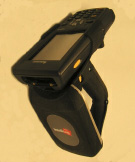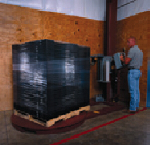May 17, 2003May 19, 2003 -- It's about 8:30 on a humid Florida evening when Larry Brady strides into the elegant restaurant at the Doral Country Club. Brady is chairman and CEO of Unova, and president of its Intermec Technologies Corp. unit. He's clearly relaxed and wears a broad smile as he goes from table to table, greeting some of the journalists and analysts attending his company's annual user conference. Unlike the heads of most technology companies, Brady actually has good reason to smile: Intermec's revenue has grown by more than 10 percent for each of the past three quarters.
"Companies have paid down their debt, and they're now investing in technologies that make them more efficient," he says. "We're benefiting from that."
Intermec makes bar code scanners, label printers, wireless local area networking equipment, and handheld computers -- products that make it possible to capture data virtually anywhere. The Everett, Wash.-based company is also poised to take advantage of the growing interest in RFID. It has established alliances with major players like IBM Global Services, which is the company's global systems integrator, and Oracle, which is working with Intermec to RFID-enable it's warehouse management software (see Oracle, Intermec Team on RFID App).
"We're seeing tremendous interest in RFID," says Brady. "It hasn't translated into a big increase in sales yet, but the interest is clearly growing."
Intermec was founded in 1966 and introduced the first portable bar code scanner five years later. Since then, it has been a leader in data-capture technology and related infrastructure. The company was acquired by Litton Industries in the early 1990's and remained under Unova when Unova was spun out of Litton in July 1997. That same year, Intermec purchased United Barcode Industries in Europe and nearly doubled in size.
In 1997, Intermec made another acquisition that was less publicized but which may turn out to have huge significance: It purchased IBM's portfolio of RFID technology and intellectual property. Intellitag RFID tags and readers operate in the UHF frequency range (915 MHz), as well as at 2.45 GHz. You can read the tags or write data to them from 15 feet (3 meters) away. The tags carry 1,024 kilobits of data, so you can store not just a serial number on them, but also application information related to the tagged object.
Intermec sells two fixed readers, the 2100 UAP, and the newer ITRF, which comes with four addressable antenna ports and RS232 and RS422 serial ports. The serial ports make it easy to connect the reader to industrial equipment, such as a conveyor belt PLC, to identify and control the movement of work-in-process items, containers, totes, pallets and other objects, based on information stored in an RFID tag.
The company's handheld reader, called the Sabre 1555 Laser Scanner, reads bar codes, as well as RFID tags. It has a read range of more than 6 feet (two meters) and can write to all Intellitags. Intermec is also developing 915 MHz and 2.45 GHz readers in PCMCIA cards, so companies can add RFID readers to existing handheld computers for light industrial use. For the heavy lifting, the company is working on a grip for its 700 Series mobile computer, with a built-in RFID antenna. The 700 Series is a Windows CE/Pocket PC device that can transmit data over a wireless LAN using the 802.11b standard.
Later this year, Intermec will also introduce a UHF reader designed to work under European RF emission and duty cycle regulations. Intermec worked with Philips Semiconductor to adapt Philips' I-Code technology to create a chip that could be used in the UHF band worldwide. Intermec is also considering licensing Philips' 13.56 MHz technology to provide more options for customers, according to Richard Mahany, Intermec's VP of products. "Some customers want to use 13.56 MHz, and for some applications it makes sense," he says. "[Sometimes] UHF is overkill."
Today, RFID sales make up less than 5 percent of Intermec's more than $600 million in annual revenue. That's still a big number in the RFID industry, but the company is taking a fairly conservative approach to the market, preferring to focus on areas where there are clear benefits for customers.
The company's main markets, according to Jim Evans, VP for Intellitag marketing and business development, are industrial manufacturing, transportation/logistic, consumer goods manufacturing, retail, homeland security and field services. "Industrial manufacturing is our flagship, because that's where our origins are," says Evans. "It’s what our people are good at, and it's what our partners do best."
Intellitag technology is used by Mack Truck to track engines on an assembly line. A company that manufactures battlefield drones operated by the US military tracks components going into the remote-control aircraft as they are being manufactured. Old Dominion Freight Line is tagging its fleet of 2,600 trucks with Intellitags so they can be identified at the gates of its distribution centers and directed automatically to the right dock door. The US Immigration and Naturalization Service is issuing Intellitag smart cards to speed low-risk vehicles through border crossings in the Pacific Northwest.
All of these applications are in closed-loop systems. While Intermec believes RFID offers great opportunities to gain efficiencies across the supply chain, the lack of well-established standards and the current state of the market mean those benefits won't be achieved for several more years. "The places where the technology is being adopted now are operations that are totally contained within one enterprise," says Mahany. "Companies are starting to roll out this technology because they can control it from end to end."
The company has also developed a tag that can be mounted on reusable plastic containers. The read-write tags in protective housing are more expensive than the cheapest read-only tag, but the benefit is they can be reused over and over and last as long as the container. And since data can be written to the tag, employees scanning the tags have access to information anywhere. "We think that read-write technology gives a whole new degree of freedom into how supply chains can be managed and to the precision to which they can be managed," Mahany says.
Intermec works through system integrator partners. The company has certified more than 75 so far, but clearly the most important one is IBM Global Services. The two companies signed a partnership deal about 18 months ago under which IBM Global Services because Intermec's global systems integrator. On any project, IBM has the right of first refusal. That gives Intermec a way to deliver not just tags and readers, but complete systems that provide business value.
"We have a professional services group that does site surveys for how to deploy systems," says Scott Medford, Intermec's VP of global alliances. "But we turned to IBM to do the consulting for us. If we go out to the market and just sell tags and readers, it won’t go anywhere. You have to change the way companies do business. So we went to IBM and said: `Will you be our integrator and help us change the world?', and they said yes."
Why did IBM choose to work with Intermec when it could have chosen any RFID company? "Intermec's a leader in this space," says Adel Al-Saleh, general manager of global wireless e-business for IBM. "They specialized in a couple of areas. They have strong technology, good expertise in the products they have, and they are committed to the partnership."
Intermec also has wireless infrastructure products and expertise that's becoming increasingly important to company's deploying data capture technology. Intermec was the first company to put three kinds of radio devices in one handheld device -- cellular, 802.11b, Bluetooth -- but companies weren't able to take advantage of the technology until IBM upgraded its middleware. WebSphere now enables a device to switch from one type of wireless network to another during the same session.
Both IBM and Intermec are essentially infrastructure providers, and both believe that companies want open systems that will allow them to build on the infrastructure and use hardware and software from third parties. "Our customers' businesses are too important for them to be dominated by a monopoly supplier," Mahany says. "They are going to want competition and options. If we are going to be their infrastructure supplier of choice, we have to give them flexibility."
The company is also a member of the Auto-ID Center, which is attempting to create a global numbering system -- the Electronic Product Code -- for tracking unique items worldwide. Intermec supports the goal of creating an electronic version of the bar code numbering system, but Mahany says it has a philosophical differences with the center's goal of creating low-cost tags that carry only a serial number.
"We think of RFID systems as a distributed database, where each of the tag systems is an element of the database," says Mahany. "The rules of who has the right to that see that information, to change that information, is a complex activity, and it’s important that the enterprise establish those rules. ISO has been identifying certain elements that will be fixed and certain elements that will be variable in the way the information will be utilized or made available for use. We believe that there's significant value in allowing the information to change over time as an item moves through the supply chain."
The Auto-ID Center's vision is for data related to a product to be stored in a separate database on a server. The problem Mahany sees is that workers scanning RFID tags in a manufacturing facility, warehouse, or retail stockroom need immediate feedback about what to do with an item. For instance, if you are building a pallet and an item doesn't match the electronic shipping order, the system needs to alert the worker instantly that there is a problem.
"It's not a big deal if you are working with a small set of items," Mahany says. "But in the future world, when you are talking about global companies with thousands of participants . . . there's a time latency issue. How do you get information into and out of the database, so you can continue your application? We think that this is going to be a significant issue."
Mahany points out that if you have reusable plastic containers filled with fresh fruit in distribution center, it may be crucial for workers to know which batch is the oldest and likely to go bad first. Other critical data, such as which store the container should be sent to, can be written to the tag, so anyone touching the item can have instant access to the information.
"If [workers] have to read the information on the tag and go to a big database to find out what the item is and whether it's the one they are looking for . . . it will bog down supply chains at time when everyone is trying to accelerating supply chains," Mahany says. "That's why we're betting that the approach of Intellitag ultimately will be of more benefit than a reliance on a large central database."







